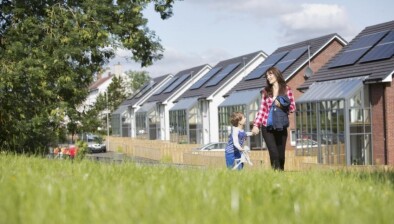Black’s Blog: It’s the cost of change, not the price of heat pumps. And what’s ESG?
Jimmy Black writes about the latest episode of the Scottish Housing News Podcast, with Link Group’s finance director Nick Pollard.

Jimmy Black
I used to sit on the committee of a local authority pension fund, and I made unpopular suggestions. I’d say “Let’s stop investing in tobacco,” only to be told “We have a fiduciary duty to continue pushing this lethal drug as it provides stable returns.”
Or I’d say, “Let’s invest in building social housing.” Answer “No, we get a better return from tobacco.” Being socially responsible investors meant occasionally voting against a CEO’s ludicrous pay rise, or avoiding stocks with dubious associations.
Now climate change has made real socially responsible investment more attractive, with Mark Carney, formerly head of the Bank of England, claiming to have $130 trillion dollars of private finance to fund the green transition. And as Nick Pollard tells us in our podcast, those monies are looking for good homes.
SHN Editor Kieran Findlay and I met Nick online to talk through the Environmental, Social and Governance (ESG) framework which is becoming ever more important for investors. It’s not just about high ideals and a social conscience. There is evidence that some ESG compliant investments are outperforming many of the traditional high earners; and “ESG shortcomings” may deter investors such as the Scottish Investment Trust from backing projects.
This is all good news for the Link Group, which has just done an £80 million deal with Scottish Widows to finance new homes built to exacting environmental standards. In a recent news release, Nick Pollard said, “This is an exciting new funding deal with Scottish Widows, which is committed to ESG funding and the climate agenda.”
Two factors helped to make Link’s proposals attractive to investors. Firstly, Link has adopted a Business Sustainability Plan, and second, they are committed to ESG accreditation via Ritterwald.
The long and short of it is that the good things which housing associations do are now good business for private investors. Nick believes money will be available in the markets for ESG compliant housing association projects for some time to come, even if interest rates increase.
If the housing sector does get its hands on some of that global $130 trillion, will Scotland grab enough to cover the £33 billion cost of bringing Scotland’s old, draughty, inefficient homes up to scratch?
Nick’s view is that the housing sector may not fully understand the costs of retrofitting… yet. He quotes estimates from consultants and others of “enormous costs” of £30,000 or £20,000 per home, but questions their accuracy.
Interestingly, he thinks these figures may be too high. He thinks heat pumps, hydrogen boilers and all the other new tech solutions which have yet to prove themselves will reduce in price as they come to market.
Nick also points out that housing associations already plan their asset management over a thirty year period, and have therefore already allocated funds for replacement heating systems and improved energy efficiency. Take that into account, and the “cost of change” looks much less. Nervous board members in Scotland’s social housing landlords may find planning for the “cost of change” less daunting than those enormous estimates although still a challenge.
Answering a question from Kieran, Nick agreed that Link Group’s size and stability had been a big plus when negotiating in the money markets, but expressed personal fears that smaller housing associations could find attracting finance more difficult. “Community-based housing organisations are the greatest asset that this sector in Scotland has. They absolutely meet that social metric we talk about in ESG – they’re able to deliver because they get close to the people they serve and support.
“But they are our greatest weakness as well, because we have 150 housing associations where 80% of them are less than 1,000 units in size, and that creates an issue with critical mass.”
The challenge is to develop funding frameworks which will make finance available to all.
Where are the tenants in all this? Do their rents rise to pay back all the borrowing? Nick is adamant that Link Group is fully committed to affordable rents for people on low incomes. “We need to make sure our product is affordable in the future, and we can’t price ourselves or our tenants out of the market, end up with high voids and end up with bad debts as a result of that.”
Could it all go wrong? Nick said he is fearful of a “race to innovation” where some organisations buy products which later become irrelevant in the short to medium term. Link’s policy for energy efficiency is resolutely “fabric first”. Although the Group has installed heat pumps and district heating schemes in rural locations, Nick is not joining that race to innovate just yet.
“We have a track record of being cautious, because tenants’ money cannot be wasted.” Amen to that.
This blog and episode 2 of the Scottish Housing News Podcast is part of our #COP26SHN feature in conjunction with our sister publication Scottish Construction Now showcasing the efforts of Scotland’s dynamic affordable housing sector to tackle the climate crisis.
New contributions are still welcome and feel free to join in the conversation on social media using #COP26SHN.








